Posted by Anita on 04.18.08 8:09 PM
 When I read that Shuna Lydon was teaching her legendary pastry tutorial — a class that, by her own admission, she’s taught so many times she’s lost count — I leapt at the chance to sign up. The last time I had the pleasure to learn at her elbow, I picked up countless little tricks for making outrageously tasty seasonal fruit desserts.
When I read that Shuna Lydon was teaching her legendary pastry tutorial — a class that, by her own admission, she’s taught so many times she’s lost count — I leapt at the chance to sign up. The last time I had the pleasure to learn at her elbow, I picked up countless little tricks for making outrageously tasty seasonal fruit desserts.
This time out, I finally learned why my usual pie-dough recipe is fine for savory applications like quiche, but not so hot for desserts. I got to see and feel where I’d been going wrong in my previous pie-making expeditions. As a side benefit, I got to hole up inside a breezy commercial kitchen on one of the hottest days of the year, relaxing into the busy charm of a kitchen full of women. Perhaps best of all, though, I got to come home with one seriously gorgeous pie crust for my troubles.
As I carefully ferried my flaky cargo across the bay in an insulated bag, visions of oozy pastry goodness danced before my eyes. But as bountiful as our spring produce is here already, we’re in that awkward in-between stage, fruit wise. It’s too late for apples, way too early for blackberries. Strawberries are coming into season, but I don’t really like them cooked. I’d hoped to have enough lemons off of our tree by now to attempt a lemon meringue, but you can’t rush Mother Nature. So I dusted off the cookbooks and went looking for options.
There it was, smack in the middle of my 1961 edition of The Joy of Cooking. A long-forgotten childhood favorite, that humble all-American dessert known as black-bottom pie. Line a simple pastry crust with chocolate custard (or ganache, if you’re feeling modern and fancy), cover with a rum-kissed custard, and top with whipped cream. Even with the cheapest ingredients, it’s indisputably delicious, even if a bit homely. When made with top-drawer bittersweet chocolate, pastured eggs, and the best dairy you can find, this simple combination turns into a dessert worthy of a pastry chef’s crust.
I separated four Marin Sun Farms eggs, and right away I could tell I was in for a treat. These eggs are always delicious, but some weeks — especially in the winter — they’re not especially gorgeous. These were a sure sign of spring: Yolks so yellow they were almost-orange standing proudly atop solid whites. Separating them felt almost cruel, as each half clung tenaciously to the other.
Cooking the custard until it was thick enough to coat the back of a spoon took mere moments — not the 20 minutes that Mrs. Rombauer instructed. Whipping the whites (to fold back into the custard) was equally swift: Even using a wimpy hand-held mixer, they flew right past soft peaks and into firmness in a matter of seconds. When yolks and whites were reunited, the resulting rum chiffon stood high in the bowl without the usual gelatin stiffener.
And the taste? Oh, my… so decadent. I can’t give away all of Shuna’s pie-crust secrets — though they’re there for the taking if you know where to look.

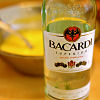
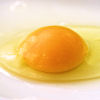


Black-Bottom Pie
1 pie shell, blind baked and cooled to room temperature
1/2 T (approx. 1/2 packet) gelatin*
2 cups whole milk
1/2 cup sugar
4 tsp cornstarch
4 eggs, separated, with 1 white discarded
1-1/2 oz unsweetened chocolate, grated or shaved
1/2 tsp vanilla
2 T white rum
1/4 tsp cream of tartar
1/4 cup sugar
1 cup whipping cream
2 T confectioners sugar
1/2 oz bittersweet chocolate, for shaving
If using gelatin, soak in 1/4 cup cold water and set aside. Scald the milk. In a small bowl, add the sugar and cornstarch, and whisk gently to combine; set aside. In a medium metal bowl, whisk the egg yolks until light in color. Slowly stir the hot milk into the eggs with a wooden spoon or heatproof spatula, then add the sugar mixture.
Bring a cup or two of water to a simmer in a medium saucepan. When you’ve reached a stable, steady simmer, place the metal bowl over the steam to cook the custard. Make sure that the water is not touching the bottom of the bowl; you’re cooking with the steam, not by direct water contact. Stir constantly with the spoon or spatula, making sure no hot spots develop. The custard is ready when it thickly coats the back of the spoon; this can take anywhere from 5 to 20 minutes, depending on the freshness of your eggs, the thickness of the bowl, and the speed of your simmer.
Place the grated unsweetened chocolate in a medium bowl. When the custard is done, immediately measure out 1 cup of the cooked custard into the bowl of chocolate, and stir until the chocolate melts and combines with the custard. Add the vanilla and a pinch of salt, and stir to combine. Pour the chocolate into the prepared pie shell, spreading evenly around the bottom.
If using gelatin, add it to the remaining custard while still warm, then add the rum; stir all until combined and the gelatin completely dissolves.
Using a stand mixer or electric hand mixer, beat the egg whites until stiff but not dry. Continue to mix while gradually adding the granulated sugar, a teaspoon at a time to keep from deflating your eggs.
Fold the whipped egg whites into the custard. Add the rum custard to the pie shell atop the chocolate layer, and chill the entire pie until set (about an hour).
When ready to serve, whip the cream to stiff peaks, then add the confectioners sugar. Cover the custard layer with whipped cream, and garnish with chocolate shavings or chocolate curls.
Pie will keep, in the fridge, for a couple of days.
—–
* Note: Most recipes call for a full packet of gelatin, which I find makes for a very firm, almost artificial-feeling chiffon. You can reduce it to half that amount, as noted here, to keep the texture less spongy. If you want the pie to be strictly vegetarian, the gelatin is optional providing that you’re using very fresh eggs, that you don’t stint on fully whipping them to stiff peaks, and that you don’t mind your custard layer being a little loose. (I actually prefer it this way myself.)
Also, the egg whites are essentially raw here, so the usual food-safety caveats apply.
—–
This little slice of yolk-yellow love also happens to be our entry for A Taste of Yellow, a blog event now entering its second year. Hosted by Barbara of Winos and Foodies, A Taste of Yellow features entries from food bloggers around the world — last year’s inaugural edition boasted 149 entries! — in support of LiveSTRONG Day, the Lance Armstrong Foundation‘s initiative to raise awareness and funds for the cancer fight.
 We dedicate our Taste of Yellow post both to our hostess Barbara, in her ongoing efforts to remain cancer-free, and to our friend Briana. Many of you know her blog, Figs with Bri, where she posted Wednesday about her recent setback: breast cancer has metastasized to her lungs. Since then, her site’s gone dark and her email account is offline. We’re keeping Bri and her husband Marc in our thoughts and prayers, and hoping for the very best.
We dedicate our Taste of Yellow post both to our hostess Barbara, in her ongoing efforts to remain cancer-free, and to our friend Briana. Many of you know her blog, Figs with Bri, where she posted Wednesday about her recent setback: breast cancer has metastasized to her lungs. Since then, her site’s gone dark and her email account is offline. We’re keeping Bri and her husband Marc in our thoughts and prayers, and hoping for the very best.
baking, classes, dessert, East Bay, other blogs, recipes
10 Comments »




Posted by Cameron on 04.13.08 2:20 PM
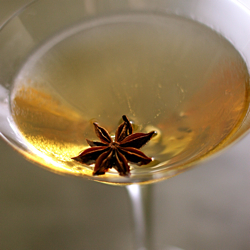 A month or so ago, at last unable to ignore the murmurs of delight circulating around the cocktail world, we sought out a bottle of Rhum Clément Creole Shrubb, an orange liqueur from Martinique. Made by infusing a blend of white and aged rums with spices and bitter orange peels, Creole Shrubb turns out to be quite different from the usual, more-neutral orange liqueurs. Its complexity intrigued us, but because we knew its dusky mysteriousness would make it an imperfect match for existing recipes, the Creole Shrubb languished on our “try me” shelf.
A month or so ago, at last unable to ignore the murmurs of delight circulating around the cocktail world, we sought out a bottle of Rhum Clément Creole Shrubb, an orange liqueur from Martinique. Made by infusing a blend of white and aged rums with spices and bitter orange peels, Creole Shrubb turns out to be quite different from the usual, more-neutral orange liqueurs. Its complexity intrigued us, but because we knew its dusky mysteriousness would make it an imperfect match for existing recipes, the Creole Shrubb languished on our “try me” shelf.
Last week, we received a bottle of Domaine de Canton, a ginger-cognac liqueur created by John Cooper (brother to Rob Cooper, creator of St. Germain) that has received a fair bit of positive press. As soon as I heard “ginger,” a light bulb went off in my head. Perhaps we’d finally found a companion for Creole Shrubb’s exotic overtones — and just in time for this month‘s fruit liqueur edition of Mixology Monday.
Creole Shrubb’s orange spice would be a natural match for the gingery Canton. Their families would get along, knit together by a shared history of tropical French colonialism: Creole Shrubb from les Antilles, Domaine de Canton with its roots in Indochine. Creole and Canton would fall in love and have beautiful little minibar bottles. Truly, I am the yenta of booze.

And yet, while the path to true love glowed ahead like a sunset on tropical shores, there was the danger this marriage of two sweet principals could become a sticky, sappy affair that would destroy itself in an explosion of pet names and babytalk. (“No, I wuv *you*, Cherie!”) Clearly, a sharp, antiseptic, perhaps even military chaperone was necessary — a no-nonsense personality to temper the flighty natures of our two romantics. I scanned the liquor cabinet and a grizzled naval officer stepped forward: Plymouth gin.
I must modestly admit that the first meeting of the three was a roaring success. I began by introducing them in equal amounts, reasoning that none would easily get the upper hand. These proportions turned out to be nearly ideal. When it seemed that the conversation could use a bit of lubricant, I blessed the vessel with a drop of bitters, and the addition brought the group together in even greater harmony.
Should you wish to arrange your own meeting, I have provided a guide below. If you must substitute, be prepared to tinker with the proportions. The penetrating sting of the Plymouth gin is especially (and surprisingly) important.

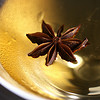



Asian Orange
1 oz Plymouth gin
1 oz Domaine de Canton
1 oz Rhum Clément Creole Shrubb
2 dashes Angostura bitters (or one dainty drop of Fee Brothers Whiskey Barrel Aged)
Combine in an ice-filled glass and stir until chilled. Strain into a chilled cocktail glass. Garnish with star anise, if desired.
Drink of the Week, drinks, Mixology Monday, recipes
8 Comments »




Posted by Anita on 04.07.08 4:22 PM
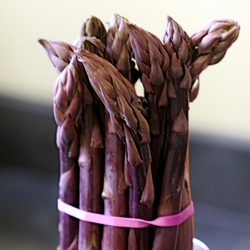 I think it’s safe to say that by any objective measure, Dark Days are well behind us here in San Francisco. Asparagus has been on the farm tables for a month, strawberries made their Ferry Plaza debut this Saturday, and — hooray! — the first pasture-raised chicken of 2008 made its way into our bag (and our bellies) yesterday.
I think it’s safe to say that by any objective measure, Dark Days are well behind us here in San Francisco. Asparagus has been on the farm tables for a month, strawberries made their Ferry Plaza debut this Saturday, and — hooray! — the first pasture-raised chicken of 2008 made its way into our bag (and our bellies) yesterday.
Spring has indeed sprung. And with the dawning of a new season comes the end of the Dark Days Eat Local Challenge.
I know you probably won’t be shocked to hear that April 1 didn’t look a whole lot different in our kitchen than March 31. We’re not going to stop hunting down locally produced foods just because we aren’t documenting every last morsel, after all. Three of the last five dinners we’ve eaten have been made with 100% local ingredients, so I think we’re safely launched down this particular path.
 And for that, I owe huge debt to Laura — for dreaming up Dark Days, for hosting the weekly roundups last fall, and for extending the challenge into 2008 when we all clamored for more. I can only imagine how she manages her own blog and handles her roundups of every Dark Days blogger in the country, all while moving onto her new farm, raising a new brood of chicks, and working a full-time job. (Honestly, I’m exhausted just thinking about it…) I know in my heart that we’d never have dug as deep into our food chain if it hadn’t been for the thrill of the challenge, and knowing we had a built-in audience of Dark Days participants who would share our excitement.
And for that, I owe huge debt to Laura — for dreaming up Dark Days, for hosting the weekly roundups last fall, and for extending the challenge into 2008 when we all clamored for more. I can only imagine how she manages her own blog and handles her roundups of every Dark Days blogger in the country, all while moving onto her new farm, raising a new brood of chicks, and working a full-time job. (Honestly, I’m exhausted just thinking about it…) I know in my heart that we’d never have dug as deep into our food chain if it hadn’t been for the thrill of the challenge, and knowing we had a built-in audience of Dark Days participants who would share our excitement.
Although we’ll stop with our periodic Dark Days wrap-ups, you haven’t heard the last of our locavore ways. In fact, I had high hopes of debuting a new “Bay Area Pantry” page this weekend, showcasing all the products we’ve found that are grown or produced within our foodshed radius. The good news is that it’s 90% ready; the bad news is that time ran out on me, and the final Dark Days roundup must go on, with or without me. I still need to add some links, photos, and section headings, but I’ll let you know when the pantry is fit for public consumption.
In the meantime: Here’s to spring — Let the asparagus-gorging begin!
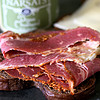
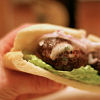
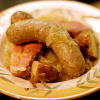
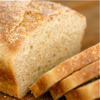
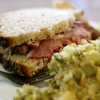
Dark Days Ticker — March 16-31
– Dark Days dinners at home: 9 out of 16
– Locavore dining-out: MÅno, O Izakaya, Marin Sun Farms butcher shop / tour lunch
– New recipes: Reuben sandwiches, feta-stuffed lamb burgers, English muffin bread
– Old faves: Not-Spam and Eggs, choucroute garnie, gumbo, beef stew, Thai beef salad
– Freezer fodder: A16 meatballs, beef stew, Mamster’s carnitas, pasta bolognese
New local items in the pantry:
Middle Eastern Baking lavash (Millbrae)
Hamati pita (San Bruno)
Sconehenge English muffins (Berkeley)
Achadinha brined goat feta (Petaluma)
Fatted Calf sauerkraut, andouille, bockwurst, pastrami (Napa)
Marin Sun Farms slab bacon (Point Reyes)
Alexander Valley Gourmet sauerkraut
cooking, Dark Days challenge, locavore, other blogs
6 Comments »




Posted by Anita on 04.06.08 12:03 PM
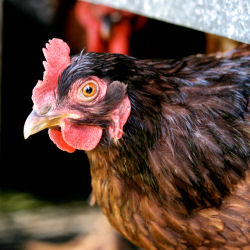 Before Niman Ranch started raising their herds on Iowa feedlots, their marketing materials bragged about “happy cows with ocean views”. Last Sunday, as we popped over the crest of Pierce Point Road and saw limitless green pasture dotted with black steers overlooking the deep blue waters of the Pacific, I gasped: It was exactly the scene that I’d held in my mind’s eye all these years. Only this land and these cattle belong to Marin Sun Farms, the ranch that supplies us with most of our eggs and meat.
Before Niman Ranch started raising their herds on Iowa feedlots, their marketing materials bragged about “happy cows with ocean views”. Last Sunday, as we popped over the crest of Pierce Point Road and saw limitless green pasture dotted with black steers overlooking the deep blue waters of the Pacific, I gasped: It was exactly the scene that I’d held in my mind’s eye all these years. Only this land and these cattle belong to Marin Sun Farms, the ranch that supplies us with most of our eggs and meat.
Even a week after our visit, I’m having a hard time expressing the depth of my awe for what David Evans is doing out on his Historic H Ranch, just 50 miles north of San Francisco. David’s family has farmed this same land since the early 1900s, although they were forced to sell it in the 1970s under the eminent domain act that created the Point Reyes National Seashore. The family leases back the land under what seems to be very tenuous circumstances: 5 year terms and government oversight of terribly minute details like the size of chicken flocks. Needless to say, it’s not the sort of sustainable permanence that makes this consumer particularly content.
Pronounced David’s way, the enterprise responsible for much of our weekly protein is properly known as “Marin Sun Farms” not “Marin Sun Farms.” Like his mentor Joel Salatin — who famously explained to Michael Pollan that he was a “grass farmer” — David takes pains to emphasize that his husbandry converts solar energy, by way of living pasture, into proteins that humans can digest. It’s half clever and half hokey, but undeniably true.
We started our tour overlooking the pasture where cows and calves ambled up and down spring-green hills, lolling in the lush grass or drinking from a large, clear pond. David talked at length about his ideology and his farming methods, explaining how herds — both chickens and cows — are moved to a different patch of land each week, preserving the pasture from over-grazing and enhancing the soil with their manure.
We peeked into a converted freight trailer turned chicken nursery, spying four gaggles of Easter-perfect chicks peeping around under heat lamps, pecking away at their feed. From there, we strolled down a wide lane to look in on David’s sister’s goat herd, busily clearing a scrubby yard where vegetables had been grown over the previous winter.
Beyond the goat yard, we saw two quonset hut-shaped structures on a distant hillside, our first glimpse of the farm’s egg-laying operation. Built of canvas-like material stretched over simple wood frames, these chicken houses open directly onto open pasture, without any physical barriers to any one of the chickens flying or wandering off. Apparently their social structure makes that unlikely; they’re much more apt to leave in the clutches of a predator, according to David. Perhaps half of the chickens roosted inside their homes, and the remainder scratched and pecked and flapped away outside in the open air. Glancing at the wide range of breeds, I suddenly understood the diversity of the colors and sizes of the eggs in our weekly dozen.
Many of us remarked with surprise that this egg-laying flock included a fairly large number of roosters, in addition to the laying hens. “I don’t do it so we can say the eggs are fertile,” said David, “But I know that I wouldn’t be happy in an environment without females, and I don’t think any of you ladies would be happy in a world without men.” Even as an unrepentant omnivore, it’s hard to wrap your brain around someone who makes his living selling meat treating his product with such humane regard.
Up the road a piece, we called on the broiler flocks, grown-up versions of the fuzzy peeps we’d seen pecking in the nursery. Penned in movable, mesh-covered yards — half in sun, half in shade — these birds were, quite frankly, the ugly ducklings of the farm. Where the laying hens are diverse and beautiful, Cornish Cross broilers look like the freaks of nature we’ve bred them to be. Sparsely feathered, dull around the eyes, and unbelievably gawky, these aren’t birds you feel too much sentiment toward. Still, they’re cared for with the same meticulous attention. They’re fed organic cracked grain, supplementing all the insects and grubs they can forage from their patch of pasture. At the end of the week, when they’ve cleared the pests and fertilized the land beneath their enclosures, their coops are canted up on a large dolly and rolled forward to a new stretch of green grass.
Sounds bucolic, and it certainly looks that way, too. Are things 100% perfect on this pastoral land? I’m sure they’re not. I would have been happier not knowing that Marin Sun Farms broiler chicks are fed imported Chinese soy until they’re old enough to digest corn and grubs. Or that David feels that heirloom birds are just too expensive (twice the cost of the already pricey hybrids he brings to market, he says) and don’t taste any better than the ugly mutants. Or that most of the calves born at his parents’ H Ranch operation are destined for life on the feedlots of the Midwest, because there simply isn’t enough demand for pasture-raised beef. But despite all of the things that I wish they were doing more-perfectly, the simple fact is that I am in awe of the 99% that Marin Sun Farms is doing exactly right.
Rounding our way back to the main barn, David stopped to talk about the on-farm ‘processing’ — that is, slaughtering — that farmers are, thankfully, still allowed to do for their own poultry. As he explained that the next part of the tour was occasionally more than some visitors had bargained for, I finally focused beyond David’s shoulder, at last noticing a critical part of the farm that had previously escaped my notice. Having read Michael Pollan’s description of the Polyface Farms “abattoir without walls,” I knew enough to recognize it: The metal cones where chickens are killed and bled out, the plucking machine with its hundred rubber ‘fingers’, the well-worn worktables, the buckets for the blood and guts that get turned into the compost pile to amend the land. No roof, no walls; everything open to the sun and the wind, nature’s original sanitizers. It was all right there… right there for anyone to see, to understand.
I knew well enough we wouldn’t see any chickens slaughtered that Sunday — it happens on Thursdays, anyway, and the oldest of this season’s broilers were still a week from market, merrily clucking away in the pasture. Nothing had been slaughtered here since the old roosters and hens had come to market last winter; the killing place smelled of nothing but the hillside around us. And yet, it had the undeniable air of purpose. I won’t insult you by saying it felt holy, but I do know that there was no nervous laughter, no chatter, no wandering off to investigate something more interesting around the corner. Every one of us on that tour, kids included, was completely present there, standing inside the boundaries of the place where animals became food: The place where each bird experiences what David calls its “one bad day” on the farm.
—-
When the tour was over, we caravaned back over the road to Route 1. David treated everyone to lunch at the Marin Sun Farms Butcher Shop, a bountiful spread of Della Fattoria bread, the farm’s own rib eye and roast goat, bowlsful of aioli and horseradish cream and salsa verde, and buckets of German-style potato salad with flecked with rich bacon.
But the best part of the lunch was the beverage: David brought out “a gift” — which he couldn’t legally sell to us — of a few gallons of raw milk “just hours out of the cow” in oversized Mason jars. I’d shied away from buying raw milk at the stores, imagining that it would taste grassy or gamey. But oh, lord, what I’d been missing! It just tasted more milk-y, like a better version of the best milk you’ve ever had. Nuances of flavor, texture, and color are apparent even to the most casual observer.
Needless to say, we bought a quart of Claravale raw milk this Saturday, and I don’t expect to go back to the sterile, flat stuff anytime soon. Nor do I expect I will soon forget the windy spring morning when I looked my supper in the eye and made peace with my place on this sustainable food chain.

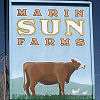
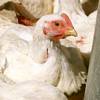

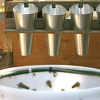
Marin Sun Farms
10905 Shoreline Highway
Point Reyes Station, CA 94956
415-663-8997
Meat CSA memberships available starting at $270 for a 6-month session
Retail sales available at the Point Reyes butcher shop, Saturday Ferry Plaza Farmers Market and Sunday San Rafael Civic Center Farmers Market
Next farm tour: May 18, 2008
Adults $30, Kids $10
(Pre-registration is mandatory)
Dark Days challenge, farmers markets, farms & farmers, locavore, meat, shopping
13 Comments »




Posted by Anita on 04.04.08 7:02 AM
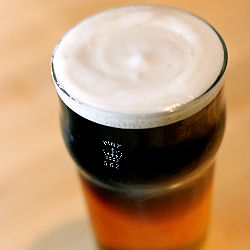 “I recommend to the Congress the passage of legislation for the immediate modification of the Volstead Act, in order to legalize the manufacture and sale of beer…”
“I recommend to the Congress the passage of legislation for the immediate modification of the Volstead Act, in order to legalize the manufacture and sale of beer…”
With these words, Franklin Roosevelt fulfilled the campaign promise that propelled him to the White House. By urging lawmakers to modify the terms of Prohibition, FDR hoped to stave off social unrest while the nation impatiently waited for the ratification of the 21st Amendment. Congress followed Roosevelt’s lead, and two weeks later the president signed the historic Cullen-Harrison Act, which amended the terms of Prohibition’s legal basis — the Volstead Act — to allow the manufacture and sale of lower-alcohol beer.
On April 7, the first legal shipments rolled out of the breweries; the story goes that the first barrel from at least one factory was brought directly to the White House. Regardless of the destination of that first delivery, there were many, many more to come: More than 1.5 million gallons of beer were reportedly consumed in the first 24 hours! Although the country’s drinkers would still endure a full eight months of relative sobriety before Repeal brought about the true end of the Noble Experiment — and the re-legalization of strong beer, wine, and spirits — at last the honest working man could return to the tavern for his pint of (weak) ale. 75 years later, we’re still celebrating.
Outside of a few localities with antiquated beer laws on the books, you’d be hard pressed today to find a commercial brew that could squeak by under the Cullen-Harrison threshold: 3.2% alcohol-by-volume beer is hardly heady stuff. But technicalities aside, there’s no reason not to enjoy a pint (or two) of your favorite ale to mark the occasion of the 75th anniversary of beer’s return to law-abiding beverage status.
The world of beer-based cocktails is a strange and storied place, where venerable working-man’s refreshers like Boilermakers and Redeyes rub shoulders with new-fangled concoctions like Turbo Diesels and Sake Bombs. But — at least in America — perhaps the best-loved mixed-beer involves no hard liquor, no soda, no juice… in fact, no adulterants at all. The Black and Tan — a beer parfait of sorts where dark stout floats atop a golden ale — may or may not have been invented Stateside, but it owes its soul (if not its actual pedigree) to Ireland. So popular is this beverage that Ben and Jerry’s introduced a limited edition, beer-flavored Black and Tan ice cream complete with adorable foam head.
Making a Black and Tan at home is a cinch: There’s no need for a specialized gizmo, just patience. Fill a pint glass — preferably the bulbous Imperial style, rather than the tapered American sort — about two-thirds full with the ale. The glass is wider at the top, so you’ll wind up with roughly equal amounts of each beer this way. Top the ale with the stout, pouring slowly over the back of a spoon.
If you use a stout other than Guinness, be sure it offers a lower alcohol content than the ale you choose, or you’ll end up with a Tan and Black. Pour too fast, and you might get something more like a Muddled Beige. If the latter happens, assure your guests they’re drinking it the way they would in the Old Country, where the drink is better known as a Half and Half, and layering’s a trick hauled out for American tourists.
Delightful as it is, the Black and Tan’s hardly the only beer cocktail that doesn’t require a shot of booze. Of the dozens of possibilities, here are a few of our favorites.



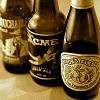
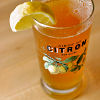
Black and Tan
1/2 stout, preferably Guinness
1/2 bitter (aka ESB-style pale ale in the US), such as Bass
Pour the ale into a pint glass, filling approximately 2/3 of the way to the top. Float the stout on top of the ale, pouring over the back of a spoon to keep the layers separate.
—-
Shandy
1/2 ale
1/2 ginger ale
Combine both ingredients in a pilsner or collins glass. Garnish with a lemon wedge or a sprig of mint.
—-
Snakebite
1/2 stout
1/2 hard cider
Combine both ingredients in a pint or half-pint glass.
—-
Panache (aka Radler)
1/2 lager
1/2 sparkling lemonade
Combine both ingredients in a pilsner or collins glass. Garnish with a lemon wedge.
—–
More beer cocktails from Drink of the Week:
– 1/5/07 Black Velvet
half Guinness, half Champagne
– 11/24/06 Michelada
Mexican beer with hot sauce, lime, and salt
beer, Drink of the Week, drinks, recipes
4 Comments »




Posted by Anita on 04.02.08 12:14 AM
As if our constant prattling here on our own site wasn’t more than enough to keep you occupied, we’re happy to announce a few other places around the Interwebs where you can see more of our content.
 Later this month, I’ll begin a regular column for Hearst’s new sustainable-living site, The Daily Green. (The site’s technically still in soft-launch mode, so be gentle.) I already work with words in my ‘real job’, so I’d never really felt the need to pursue new outlets for my writing. But I’ll admit I was swayed by the idea of rubbing elbows with some folks whose work I greatly admire: TDG’s other “New Green Cuisine” bloggers include James MacKinnon & Alisa Smith — the 100 Mile Diet / Plenty folks — and food watchdog extraordinare Marion Nestle.
Later this month, I’ll begin a regular column for Hearst’s new sustainable-living site, The Daily Green. (The site’s technically still in soft-launch mode, so be gentle.) I already work with words in my ‘real job’, so I’d never really felt the need to pursue new outlets for my writing. But I’ll admit I was swayed by the idea of rubbing elbows with some folks whose work I greatly admire: TDG’s other “New Green Cuisine” bloggers include James MacKinnon & Alisa Smith — the 100 Mile Diet / Plenty folks — and food watchdog extraordinare Marion Nestle.
The column I’ll be writing for The Daily Green will be a roundup of Sustainable, Organic, Local, Ethical eating tips called “SOLE Food Digest”, a weekly collection that aims to show readers how to tread lightly and still enjoy what they’re eating. I’ll be recapping and linking off to as many inspiring posts as I can find. No wonky policy discussions, no alarmist scary-food nightmares — just links to constructive tips, seasonal recipes, and stories about encouraging changes in our food supply… green-eating inspiration with a can-do spin.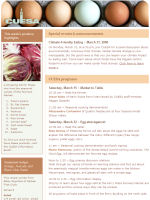
I hope SOLE Food Digest will become the perfect jumping-off point folks who are just starting down the SOLE path, and for old-time ethical eaters looking for a lighter touch. (I’ll post a link as soon as it’s live, hopefully on or soon after Earth Day.)
I’m also tickled to tell you that the good folks at CUESA — they run the Ferry Plaza Farmers Market, among other great locavore resources — have asked me to contribute photos to their newsletter and site. Those pasture-raised eggs in the banner of the March edition of the CUESA Weekly E-Letter are mine; look for my “married with dinner” photo byline, and more of my photos in upcoming editions of the newsletter, and also on the CUESA homepage in the coming months.
 A little further afield: Cameron and I are joining 30 or so of the world’s favorite drink bloggers to produce the Tales of the Cocktail blog. All of us will be live-blogging from New Orleans in July, of course, but you won’t want to wait to put the Tales blog in your RSS reader. There’ll be plenty of pre-event posts covering all sorts of topics that are sure to pique your interest, even if you’re not planning to attend the year’s most anticipated cocktail event. And if you are joining us in New Orleans, don’t forget to head over to the main Tales of the Cocktail site, where tickets
A little further afield: Cameron and I are joining 30 or so of the world’s favorite drink bloggers to produce the Tales of the Cocktail blog. All of us will be live-blogging from New Orleans in July, of course, but you won’t want to wait to put the Tales blog in your RSS reader. There’ll be plenty of pre-event posts covering all sorts of topics that are sure to pique your interest, even if you’re not planning to attend the year’s most anticipated cocktail event. And if you are joining us in New Orleans, don’t forget to head over to the main Tales of the Cocktail site, where tickets have just gone on sale will go on sale real soon now, and discount ($99!) rooms are available for the show hotel, the venerable Hotel Monteleone.
And last but not least… I’m assured that this is not just some elaborate April Fool’s Day joke: Our post about Armandino’s Salumi is featured rather extensively in the Internet Explorer 8 Activities demo. We have no idea how this happened, and the irony is not lost on us that we’re diehard Firefox/Mac fans here at Married with Dinner HQ.
drinks, farmers markets, geekery, other blogs
14 Comments »




Posted by a Special Guest on 03.28.08 7:03 AM
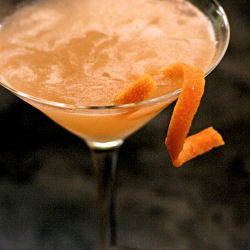 Editor’s note: Our pal Sean returns once again to Drink of the Week guest-bartender duties with a delicious, prettily pink cocktail inspired by the fabulous girl in his life.
Editor’s note: Our pal Sean returns once again to Drink of the Week guest-bartender duties with a delicious, prettily pink cocktail inspired by the fabulous girl in his life.
—-
Last week, we celebrated one lunar year with our daughter dog, Reese. Like proper San Franciscans, we simply had to throw a cocktail party to, um, mark the occasion. But what to serve? Salty dog? Perhaps. Bark-tini? Ugh, no. Greyhound? Now we’re talking.
Nothing more than vodka and grapefruit juice, the Greyhound can be lovely with brunch, but it’s maybe not the most interesting option for cocktail hour. Luckily, we had just finished our inaugural batch of pompelmocello, and so we decided to sub that in for some of the vodka. And being cunning linguists as we are, we dubbed our newfound concoction the Italian Greyhound.
The name was apt, for when we were researching breeds while ‘shopping’ for a dog, Italian Greyhounds were front-runners in our consideration. Apartment-sized, trainable and loving, they seemed like a good match for us. The one deterrent was that they have a tendency to burrow under blankets and pillows, and if you accidentally and unknowingly sit on one in its ersatz lair, you can kill it. Maybe, we thought, we wanted something a little sturdier. In the end, we got our Manchester Terrier mix pound puppy, who at 17 pounds swaggers with the attitude of a dog many times her size.
Alas, there already exists a cocktail called the Italian Greyhound, basically your standard Greyhound with a float of Campari on top. It’s just as well, for in tinkering with the recipe further, I decided vodka wasn’t really the way to go anyhow. In order to convert the greyhound into something worthy of a cocktail glass, I had to bump up the booze-to-juice ratio, and vodka just wasn’t bringing anything to the party. Gin, on the other hand, offered enough complexity to offset the acidity of the juice.
All that remained from the original inspiration was grapefruit juice, and smaller amounts of it, but I still wanted to honor its provenance. Anita suggested dubbing it the Levriero — Italian for greyhound — and so a new cocktail was fledged.

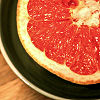
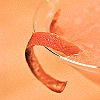

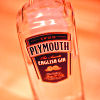
Levriero
1 oz limoncello (or pompelmocello)
1 oz gin
2 oz red grapefruit juice
Shake with ice and strain into a chilled cocktail glass. Garnish with mint sprig or a twist.
Drink of the Week, drinks, holidays & occasions, preserving & infusing
6 Comments »




Posted by Anita on 03.27.08 7:57 PM
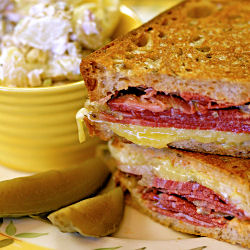 There’s a strange thing that happens in Seattle. (OK, there are many strange things that happen there, but this one is food related.) Some restaurant — usually a reasonably popular one — puts a relatively obscure but approachable item on the menu, and before you can say “hamburger with a fried egg on top”, said item pops up on menus everywhere, from divey diners to haute-cuisine haunts.
There’s a strange thing that happens in Seattle. (OK, there are many strange things that happen there, but this one is food related.) Some restaurant — usually a reasonably popular one — puts a relatively obscure but approachable item on the menu, and before you can say “hamburger with a fried egg on top”, said item pops up on menus everywhere, from divey diners to haute-cuisine haunts.
Thus it is with the Reuben, the sandwich some might call Seattle’s signature. And it’s no great mystery why: There’s something irresistibly naughty — not to mention entirely un-Kosher — about a deli sandwich that combines salty corned beef, gooey cheese, zippy Russian dressing, and crunchy sauerkraut between two slices of butter-grilled rye bread. A Reuben is the perfect antidote for drizzly, chilly Northwest weather, an overstuffed slice of golden sunshine on a plate. Served with a garlicky dill pickle and a ramekin of good potato salad, there’s hardly any better cure for grey-day blues.
Child of the sunny Southland that I am, it’s entirely possible that I had never eaten a Reuben before we moved to Jet City. I quickly made up for lost time: Fremont’s Red Door tavern used to make a pretty good example, as did our old ‘local’ pub, the 74th Street Ale House on Phinney Ridge. Once we moved across town to Madison Valley, it was only a matter of days before I discovered the heavenly Reuben — and his turkey-licious sibling, Rachel — served on just-baked sour rye at the Essential Bakery Cafe. I could probably fill an entire post with Seattle Reubens I Have Known and Loved. (Thankfully, I managed to avoid the vegan one!)
Once we moved back home to San Francisco, I don’t think I ever encountered a Reuben on a restaurant menu. I’m sure Reubens exist somewhere within our seven-by-seven grid, but so far we have yet to cross one another’s paths. It’s a sad truth that moving from city to city often means leaving behind foods (and friends) you’ve grown to love.
Luckily, once you have the right ingredients, it’s easy to make your own fabulous Reuben. Sure, you can pick up pretty good deli meats around town, but one of the the best reasons to make your own corned beef is that you’ll have plenty of leftovers. Leave the little trimmings and end bits for tomorrow morning’s hash; the best and highest use of that glistening chunk of pink, lipid-laced meat lies between two slices of good bread. Shave it thin with your sharpest blade, and don’t stop until you’ve got a goodly pile.
—-
Knowing there were Reubens in our future, we picked up a loaf New York Rye from Acme and a hunk of Spring Hill’s Portuguese cheese, which makes a better-than-decent stand-in for Swiss. We thought we would be out of luck finding local sauerkraut, until fate intervened. The good news: Not one but two of our favorite local purveyors has just recently started brining their own ‘kraut. Fatted Calf sells a chunky, tangy variety, and Alexander Valley Gourmet sells a crisper, finer-gauge flavor. Happily, both are excellent, and equally well suited to Reuben-making.
The bad news: Neither brand is (yet) available in San Francisco. Fatted Calf sells theirs over the counter at their Oxbow shop but, alas, not at their market stands. Alexander Valley is wrestling with the classic shelf-space squeeze: So far, no San Francisco shop has made room for their newest product. (There’s hope, though: Alexander Valley’s fresh pickles are already available at Whole Foods, Rainbow Grocery, and Andronico’s; if you want the ‘kraut, too, leave a note for the manager asking that they stock it. So far, the new Napa branch of Whole Foods is as close as we’ve been able to locate it.)
With two containers of locally made sauerkraut in the fridge, all that remained was the Russian dressing. We stirred together some homemade mayo, a bit of last summer’s tomato jam, a blob of local horseradish, a few chopped pickles… and got ready to griddle. Sure, Thousand Island dressing would have done in a pinch, but we decided that making a 100%-local sandwich was worth a few minutes of extra prep.
And let me tell you: It was a Reuben to make you forget all the others.
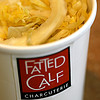
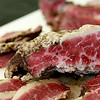


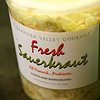
The Perfect Reuben Sandwich
Here’s the part where I would normally explain exactly how to craft the platonic ideal of a Reuben sandwich. But frankly, there’s no way I could possibly improve on the recipe we found on Epicurious, as transcribed from Arthur Schwartz’s New York City Food.
If you think the Zuni Cafe mock porchetta recipe is detailed, let me assure you: It ain’t got nothin’ on Schwartz’s step-by-step tutorial on building the proper Reuben sandwich. The devil may be in the details, but the details are in Schwartz’s Reuben.
Dark Days challenge, locavore, lunch, Seattle
14 Comments »




Posted by Anita on 03.21.08 7:02 AM
 I don’t mean to brag, but I’m a pretty macho mixer. Despite my ladylike demeanor — hey, stop that snickering! — I can get a hoary frost going on the side of a cocktail shaker with the best of the boys.
I don’t mean to brag, but I’m a pretty macho mixer. Despite my ladylike demeanor — hey, stop that snickering! — I can get a hoary frost going on the side of a cocktail shaker with the best of the boys.
But when it comes to cocktails that include a touch of egg white, I find they need a little extra oomph to keep their pretty heads about them. Plus, the amount of time it takes to shake an egg to a crisp foam means you’re likely to wind up with a rather watery drink.
Rather than tweaking the other ingredients to make up for this mechanical flaw, it seems easier to tip the laws of physics in the bartender’s favor. When making a Ramos Fizz, for example, I find it’s helpful to add just a touch of the soda to the shaker. I’m no Harold McGee, but my guess is that this small amount of priming helps the egg loosen up a little and creates a better foam, even before the final shot of soda is added in the glass.
But when you’re mixing fizzless drinks, you can’t go this route. Luckily, there’s another way to build foam without spraining your shoulder. During an early-afternoon brunch at The Alembic last fall, we spied a bartender putting the finishing touches on her fizzes with a hand-held stick blender, after shaking the ingredients first to chill ’em. Brilliant!
You don’t have to look far to find plenty of egg-based drinks to try out this frothing trick. There’s the venerable Sherry Flip, the old-school Morning Glory Fizz, the whippersnapper Silver Lining, the newly minted French Sheets, and dozens of others. But given the season — it’s spring at last! — allow me to suggest the Clover Club cocktail, an old-fashioned libation with a festive pink hue.
Although a pair of 1911 advertisements has convinced me that the original Clover Club recipe called for grenadine, I’m equally certain that the use of raspberry syrup (or better yet, muddled raspberries) was quite well established before Prohibition. The three oldest books in my cocktail collection — the Old Waldorf-Astoria Bar Book, Cocktails How to Mix Them and The Merry Mixer — call for some manner of raspberry in place of the grenadine, and a side-by-side tasting at our house showed the wisdom of that choice. Even using good homemade pomegranate syrup, the grenadine version is literally a pale second to the fruitier upstart. Without the berry flavor, it’s just a ho-hum gin sour with a little blush around the edges.
But don’t take my word for it: Try it both ways and see. You’ll undoubtedly find plenty of eggs this week to experiment with.





Clover Club
1-1/2 oz gin
3/4 oz lemon juice (some say lime)
1/4 to 1/2 oz raspberry syrup (or grenadine)
white of 1 egg
Shake all ingredients with ice for at least a minute until very well chilled. If desired, strain into a measuring cup or a second shaker can, and buzz with a stick blender for 10 seconds to create a denser froth. Strain into a chilled cocktail glass.
Drink of the Week, drinks, recipes
7 Comments »




Posted by Anita on 03.20.08 11:44 PM
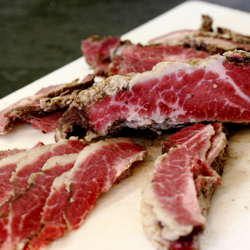 If you ask Cameron what his favorite cold-weather meal is, you might be in for a surprise. It’s not Thanksgiving turkey with all the trimmings. It’s not even a big prime rib, with plenty of leftovers for his beloved beef-and-bleu sandwiches. No, the thing my Scots-Irish husband loves best when the nights are long is New England Boiled Dinner — better known as “corned beef and cabbage” — with a hearty dollop of horseradish cream and an imperial pint of stout to wash it down.
If you ask Cameron what his favorite cold-weather meal is, you might be in for a surprise. It’s not Thanksgiving turkey with all the trimmings. It’s not even a big prime rib, with plenty of leftovers for his beloved beef-and-bleu sandwiches. No, the thing my Scots-Irish husband loves best when the nights are long is New England Boiled Dinner — better known as “corned beef and cabbage” — with a hearty dollop of horseradish cream and an imperial pint of stout to wash it down.
Like most folks, we’ve reserved this marvelously meaty meal for St. Patrick’s Day feasts. But given how cheap it is, and how much we enjoy it, I’m not entirely sure why we don’t trot it out regularly. Perhaps we got in the habit back when it was difficult to find corned beef during the rest of the year. But the last few winters, we’ve taken to curing our own brisket, so getting our hands on nice corned beef isn’t so much of a problem.
I know there are at least two of you who know our little secret: Home-cured corned beef only sounds impressively arcane; it’s actually about the easiest thing you can cure at home. The only thing you need is a 4-to-6 pound piece of brisket — point cut, preferrably — plus a few easy-to-find spices and a week’s forethought. And if you use a dry cure like the Cooks’ Illustrated recipe [link removed*] we often follow, rather than the typical immersion brine, you don’t even need a lot of fridge space. Honestly, we’ve got to do this more often… if only for the crave-inducing leftovers.
 This year’s brisket came to us from Marin Sun Farms, and a glorious specimen it was. For the accompaniments, we wandered the Ferry Plaza market and rounded up a Catalan Farms cabbage, two pounds of Little’s potatoes, a bunch of Star Route Farms carrots, a pile of Dirty Girl boiling onions, and a couple of rutabagas from Heirloom Organic. Imagine our surprise as we walked by the Happy Girl Kitchen pickle stand on our way back to the car and noticed they were selling prepared horseradish! (Yes, it was local — grown at Tairwa Knoll Farms and processed in Santa Cruz County — and delicious.) On the way home, we popped by our local microbrewery, 21st Amendment, and picked up a growler of their oyster stout. Ah, it was the easiest 100% local meal of the month, to be sure, and definitely one of the tastiest.
This year’s brisket came to us from Marin Sun Farms, and a glorious specimen it was. For the accompaniments, we wandered the Ferry Plaza market and rounded up a Catalan Farms cabbage, two pounds of Little’s potatoes, a bunch of Star Route Farms carrots, a pile of Dirty Girl boiling onions, and a couple of rutabagas from Heirloom Organic. Imagine our surprise as we walked by the Happy Girl Kitchen pickle stand on our way back to the car and noticed they were selling prepared horseradish! (Yes, it was local — grown at Tairwa Knoll Farms and processed in Santa Cruz County — and delicious.) On the way home, we popped by our local microbrewery, 21st Amendment, and picked up a growler of their oyster stout. Ah, it was the easiest 100% local meal of the month, to be sure, and definitely one of the tastiest.
The rest of the fortnight was full of other tasty tidbits, including six meals at restaurants that wear their locavore menus on their sleeves. You’ll recognize lots of old standbys in the list below, and a pair of newcomers. Let’s just say that Conduit seems to be still working the kinks out of their kitchen; they’ve only just opened, so we’ll keep mum. On the other hand, Ubuntu is old enough to know better. I wish we had loved every bite at this nationally fawned-upon Napa newcomer, but — as our friend and dining companion Cookiecrumb detailed elsewhere — the inventive flavors and gorgeous ingredients were so oversalted as to be nearly inedible. Ah, well… they can’t all be Range, I suppose.
Mercifully, we did not return home hungry. There were plenty of other delicious things we discovered on our Napa field trip, including a to-die-for packet of pastrami (from Fatted Calf’s gorgeous new shop at the Oxbow Market) that had us happily gorging on sandwiches… even for breakfast. And we also discovered another secret ingredient that we’ll share more about in our next Dark Days installment.
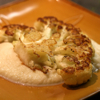


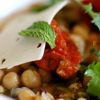
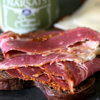
Dark Days Ticker — March 1-15
– Dark Days dinners at home: 8 out of 15
– Locavore dining-out: Range, Primavera, ubuntu, O Izakaya, Two, Conduit
– New recipes: Jamie’s stuffed potatoes, Hugh’s milk-braised pork, cauliflower steaks
– Old faves: corned beef & cabbage, egg drop soup, bean salad, Waltuck‘s chicken paprikás, grilled rib-eye
– Freezer fodder: golden veggie bisque, potstickers, chili verde enchiladas, oxtail ragu, bolognese sauce
New local items in the pantry:
– Straus Creamery cream-top milk (2% and whole)
– Marin Sun Farms point-cut brisket
– Fatted Calf pastrami (available at their Napa store only, alas!) and bierwurst
– Little‘s “all blue” potatoes
– Zuckerman’s asparagus
– Happy Girl Kitchen Co. prepared horseradish
– Andante butter
– 21st Amendment Oyster Stout (brewed with Hog Island oysters!)
– Carmel S&S Syrah (thanks, Lauren!)
– Bartholomew Park Cabernet
—-
* Edited to add: We removed the link to the Cook’s Illustrated recipe in July 2008 in protest of their bullying tactics.
beer, Dark Days challenge, holidays & occasions, locavore, meat, Napa & Sonoma, restaurants
12 Comments »




 When I read that Shuna Lydon was teaching her legendary pastry tutorial — a class that, by her own admission, she’s taught so many times she’s lost count — I leapt at the chance to sign up. The last time I had the pleasure to learn at her elbow, I picked up countless little tricks for making outrageously tasty seasonal fruit desserts.
When I read that Shuna Lydon was teaching her legendary pastry tutorial — a class that, by her own admission, she’s taught so many times she’s lost count — I leapt at the chance to sign up. The last time I had the pleasure to learn at her elbow, I picked up countless little tricks for making outrageously tasty seasonal fruit desserts. We dedicate our Taste of Yellow post both to our hostess Barbara, in her ongoing efforts to remain cancer-free, and to our friend Briana. Many of you know her blog, Figs with Bri, where she posted Wednesday about her recent setback: breast cancer has metastasized to her lungs. Since then, her site’s gone dark and her email account is offline. We’re keeping Bri and her husband Marc in our thoughts and prayers, and hoping for the very best.
We dedicate our Taste of Yellow post both to our hostess Barbara, in her ongoing efforts to remain cancer-free, and to our friend Briana. Many of you know her blog, Figs with Bri, where she posted Wednesday about her recent setback: breast cancer has metastasized to her lungs. Since then, her site’s gone dark and her email account is offline. We’re keeping Bri and her husband Marc in our thoughts and prayers, and hoping for the very best.

























































